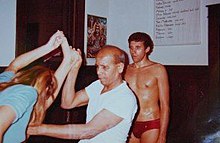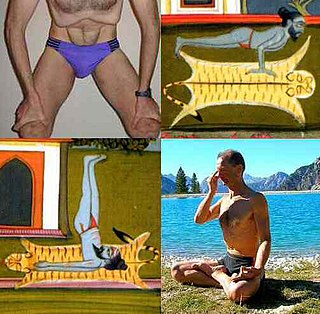
Hatha yoga is a branch of yoga that uses physical techniques to try to preserve and channel vital force or energy. The Sanskrit word हठ haṭha literally means "force", alluding to a system of physical techniques. Some hatha yoga style techniques can be traced back at least to the 1st-century CE, in texts such as the Hindu Sanskrit epics and Buddhism's Pali canon. The oldest dated text so far found to describe hatha yoga, the 11th-century Amṛtasiddhi, comes from a tantric Buddhist milieu. The oldest texts to use the terminology of hatha are also Vajrayana Buddhist. Hindu hatha yoga texts appear from the 11th century onward.

K. Pattabhi Jois was an Indian yoga guru who developed and popularized the flowing style of yoga as exercise known as Ashtanga vinyasa yoga. In 1948, Jois established the Ashtanga Yoga Research Institute in Mysore, India. Pattabhi Jois is one of a short list of Indians instrumental in establishing modern yoga as exercise in the 20th century, along with B. K. S. Iyengar, another pupil of Krishnamacharya in Mysore. Jois sexually abused some of his yoga students by touching inappropriately during adjustments. Sharath Jois has publicly apologised for his grandfather's "improper adjustments".
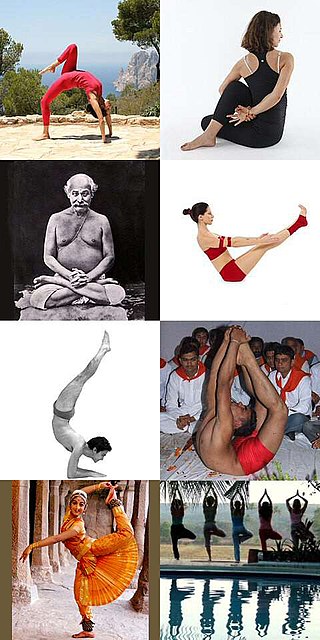
An āsana is a body posture, originally and still a general term for a sitting meditation pose, and later extended in hatha yoga and modern yoga as exercise, to any type of position, adding reclining, standing, inverted, twisting, and balancing poses. The Yoga Sutras of Patanjali define "asana" as "[a position that] is steady and comfortable". Patanjali mentions the ability to sit for extended periods as one of the eight limbs of his system. Asanas are also called yoga poses or yoga postures in English.
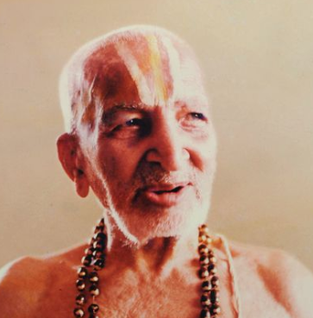
Tirumalai Krishnamacharya was an Indian yoga teacher, ayurvedic healer and scholar. He is seen as one of the most important gurus of modern yoga, and is often called "Father of Modern Yoga" for his wide influence on the development of postural yoga. Like earlier pioneers influenced by physical culture such as Yogendra and Kuvalayananda, he contributed to the revival of hatha yoga.

Sun Salutation, also called Surya Namaskar or Salute to the Sun, is a practice in yoga as exercise incorporating a flow sequence of some twelve linked asanas. The asana sequence was first recorded as yoga in the early 20th century, though similar exercises were in use in India before that, for example among wrestlers. The basic sequence involves moving from a standing position into Downward and Upward Dog poses and then back to the standing position, but many variations are possible. The set of 12 asanas is dedicated to the Hindu solar deity, Surya. In some Indian traditions, the positions are each associated with a different mantra.
The Mysore style of asana practice is the way of teaching yoga as exercise within the Ashtanga Vinyasa Yoga tradition as taught by K. Pattabhi Jois in the southern Indian city of Mysore; its fame has made that city a yoga hub with a substantial yoga tourism business.
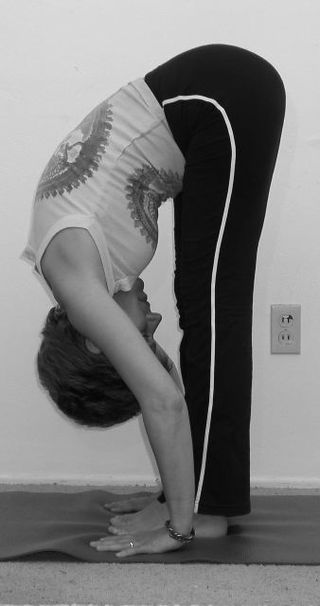
Uttanasana or Standing Forward Bend, with variants such as Padahastasana where the toes are grasped, is a standing forward bending asana in modern yoga as exercise.
Ujjayi is a pranayama employed in a variety of yoga practices. In the context of yoga, it is sometimes called "the ocean breath." Unlike some other forms of pranayama, the ujjayi breath is typically done in association with asana practice in some styles of yoga as exercise, such as Ashtanga Vinyasa Yoga.
Tadasana, Mountain pose or Samasthiti is a standing asana in modern yoga as exercise; it is not described in medieval hatha yoga texts. It is the basis for several other standing asanas.
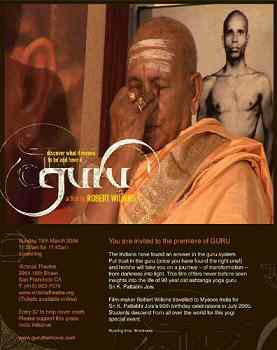
Guru is a British 2006 short documentary film about the guru of yoga as exercise K. Pattabhi Jois, directed by the BBC film producer Robert Wilkins. The film shows Jois and his grandson Sharath Rangaswamy teaching in the yogashala at the Ashtanga Yoga Research Institute in Mysore, India. It combined footage of beginner and advanced students practising the various Ashtanga Vinyasa Yoga series of asanas, from Primary to Advanced, with interviews with Jois and senior staff at the Institute, and street scenes in Mysore. The film also shows Jois's children Saraswati and Manju talk about their father. Wilkins took up Ashtanga Yoga two years before making the film. Wilkins spent several months in Mysore studying for the film.
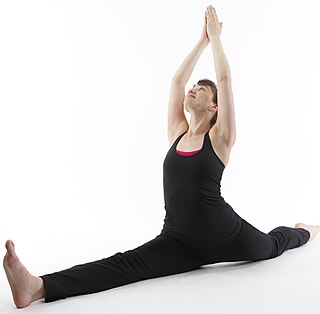
Hanumanasana or Monkey Pose is a seated asana in modern yoga as exercise. It is the yoga version of the front splits.
The Yoga Korunta or Yoga Kuruntha is a purported 5,000 year old text on yoga, said to have been written in Sanskrit by an otherwise unknown author, Vamana Rishi, allegedly discovered by Tirumalai Krishnamacharya in the National Archives of India in the early 20th century, and supposedly lost when Krishnamacharya's only copy was eaten by ants.
A vinyasa is a smooth transition between asanas in flowing styles of modern yoga as exercise such as Vinyasa Krama Yoga and Ashtanga Vinyasa Yoga, especially when movement is paired with the breath.

Chaturanga Dandasana or Four-Limbed Staff pose, also known as Low Plank, is an asana in modern yoga as exercise and in some forms of Surya Namaskar, in which a straight body parallel to the ground is supported by the toes and palms, with elbows at a right angle along the body. The variation Kumbhakasana, Phalakasana, or High Plank has the arms straight.
R. Sharath Jois was an Indian teacher, practitioner and lineage holder (paramaguru) of Ashtanga Yoga, in the tradition of his grandfather K. Pattabhi Jois. He was the director of Sharath Yoga Center in Mysuru, India.
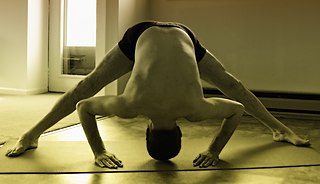
Prasarita Padottanasana or Wide Stance Forward Bend is a standing forward bend asana in modern yoga as exercise.

Yoga Makaranda, meaning "Essence of Yoga", is a 1934 book on hatha yoga by the influential pioneer of yoga as exercise, Tirumalai Krishnamacharya. Most of the text is a description of 42 asanas accompanied by 95 photographs of Krishnamacharya and his students executing the poses. There is a brief account of practices other than asanas, which form just one of the eight limbs of classical yoga, that Krishnamacharya "did not instruct his students to practice".
Srivatsa Ramaswami is a teacher of Vinyasa Krama yoga. He studied for 33 years under the "grandfather of modern yoga", Krishnamacharya. In India he teaches at Kalakshetra. He has run workshops in America at the Esalen Institute, the Himalayan Institute and many other centres. He is the author of four books on yoga.

The history of yoga in the United States begins in the 19th century, with the philosophers Ralph Waldo Emerson and Henry David Thoreau; Emerson's poem "Brahma" states the Hindu philosophy behind yoga. More widespread interest in yoga can be dated to the Hindu leader Vivekananda's visit from India in 1893; he presented yoga as a spiritual path without postures (asanas), very different from modern yoga as exercise. Two other early figures, however, the women's rights advocate Ida C. Craddock and the businessman and occultist Pierre Bernard, created their own interpretations of yoga, based on tantra and oriented to physical pleasure.

Postural yoga began in India as a variant of traditional yoga, which was a mainly meditational practice; it has spread across the world and returned to the Indian subcontinent in different forms. The ancient Yoga Sutras of Patanjali mention yoga postures, asanas, only briefly, as meditation seats. Medieval Haṭha yoga made use of a small number of asanas alongside other techniques such as pranayama, shatkarmas, and mudras, but it was despised and almost extinct by the start of the 20th century. At that time, the revival of postural yoga was at first driven by Indian nationalism. Advocates such as Yogendra and Kuvalayananda made yoga acceptable in the 1920s, treating it as a medical subject. From the 1930s, the "father of modern yoga" Krishnamacharya developed a vigorous postural yoga, influenced by gymnastics, with transitions (vinyasas) that allowed one pose to flow into the next.
